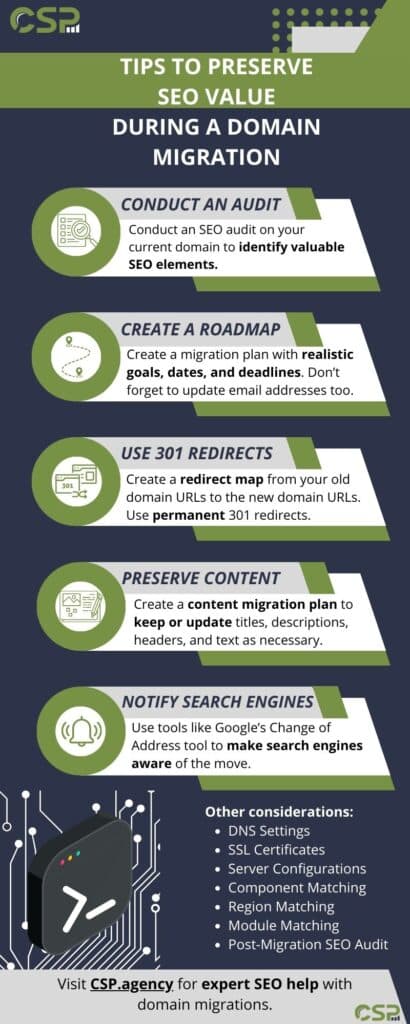A domain migration is as complex as a physical relocation. You need to ensure every detail is scheduled, everything that needs to be moved has a place to go, and everyone knows where to find you when the move is complete and you have your grand re-opening. It takes a lot of skill and planning to do it right.
The same is true for preserving SEO value during a domain migration. The SEO impact can be minimal and organic visibility can bounce back within weeks. Or, there could be a complete loss in organic visibility due to an overlooked technical SEO issue that could seriously affect your bottom line. Something as simple as neglecting to inform search engines that a change has taken place can be what causes substantial losses in organic visibility. This blog discusses the details of a successful SEO domain migration.
Understanding SEO Domain Migration
A domain migration refers to moving your website from one domain name (URL) to another. While seemingly straightforward, this shift can significantly impact your SEO if not executed meticulously and with the proper attention to detail.
Changing from myoldname (dot) com to mynewname (dot) com may seem like a simple task. However, it can have adverse effects if not done properly.
Search engines like Google value consistency and user experience above many other metrics, and a sudden domain change can disrupt their understanding of your website’s content and relevance. This often leads to a dip in organic visibility, search engine rankings, and organic traffic – a concern for any online business.
While this may cause fear and confusion, following a strategic plan can minimize disruptions. There are ways to ensure a smooth SEO handover so search engines can apply your current SEO value to your new domain.
Preparing Your Foundation for a Successful SEO Domain Migration
Before you plan your migration journey, you need a thorough SEO audit of your current domain. This audit marks the beginning of the roadmap. Here is where you get a full list of every URL in your site and identify the valuable SEO elements they each have, or need. Then, you can develop a pre and post-migration plan to transfer these SEO assets to your new domain.
Preserving the Crown Jewels of Your Content
Content is king, so be sure you preserve your crown jewels. Make sure you have a well-defined content migration plan to keep your SEO intact. You don’t want to lose meta titles, meta descriptions, header tags, internal links, or page content during the shift.
A post-migration content strategy should also be a part of your overall plan. Meta titles and descriptions may need to be updated to help search engines reclassify your site and accurately display your new brand in the SERPs.
Understanding Technical SEO During Domain Changes
A successful SEO domain migration has complex technical considerations. For example, DNS settings, SSL certificates, and server configurations all play a crucial role in the transition.
Aren’t all domain migrations the same?
No. While the basics are the same, advanced migrations can be tricky.
Basic Migration Considerations
- DNS Settings: Update DNS settings with your domain registrar or hosting provider. Common settings to be updated are:
- A Records: Connect your domain to a server’s IP address.
- CNAME Records: Point subdomains to another domain.
- MX Records: Specify mail servers for your domain.
- TXT Records: Add text information like SPF or verification keys.
- SSL Certificates: Make sure your new domain has a valid SSL certificate for security, authentication, and data protection. An SSL certificate encrypts data transmitted between a user’s browser and the web server, ensuring that sensitive information is safeguarded.
- Server Configurations: The way the server is configured can significantly impact website speed and performance. This usually means collaborating with your hosting provider or dev team to guarantee the new server is optimized for your website’s needs and maintains a positive user experience.
- Redirect mapping & testing: Implement a comprehensive URL mapping strategy. This involves creating a 301 redirect map from old URLs to new URLs to preserve SEO value and ensure a smooth user experience. Test redirects to ensure they work correctly and do not create redirect chains or loops. Use multiple sources when identifying pages on your old site to redirect (Screaming Frog, GSC, XML Sitemap, etc). If possible, keep a similar URL structure on the new domain to make both the redirect mapping and the eventual transition easier. However, if you are updating the folder structure for SEO, now is a good time to do it. This is also a great time to implement 301 redirects for any old URLs that are no longer relevant to help maintain a clean and efficient website structure. You will want expert SEO oversight for complex redirect mapping.
- Analytics and tracking: Update all analytics and tracking codes to reflect the new domain. This includes:
- Google Analytics property settings
- Google Search Console settings
- Any other third-party tracking tools
- Backlink Audit and Update: Conduct a backlink audit to identify high-value backlinks pointing to the old domain. Reach out to webmasters and request updates to the links to point to the new domain. This helps maintain the link equity and referral traffic.
- Sitemap and robots.txt: Generate and submit a new XML sitemap for the new domain. Ensure that the robots.txt file is updated to allow search engines to crawl the new site and disallow any unwanted sections.
- Communication Plan: Develop a communication plan to inform stakeholders about the migration. This includes:
- Notifying users, clients, and partners about the change.
- Updating social media profiles, email signatures, and marketing materials to reflect the new domain.
Advanced Migration Considerations
- Component Matching: Ensure that the new domain is updated across all web components and JavaScript frameworks. This is crucial to avoid crawler errors, broken links, and functionality issues. Pay attention to elements such as:
- API endpoints
- Internal links
- Form actions
- Script sources
- Region Matching: When dealing with international websites, it is important to update URLs in hreflang attributes from the old domain to the new domain. This helps search engines understand the geographical and language targeting of your pages, ensuring that the correct version of a page is served to users based on their location and language preferences.
- Module Matching: Development teams should create a replica of the configuration settings and data in the target environment to match the source environment. This replication ensures that:
- The target environment closely resembles the source environment, minimizing the risk of inconsistencies.
- Applications, settings, and data can be migrated seamlessly.
- Testing can be conducted to verify that the migrated environment functions correctly before going live.
Below is an infographic that puts it all together.
Common Technical SEO Pitfalls in Domain Migration
Check for common technical SEO errors post-migration, such as:
- Broken internal links in content that was copied over 1:1 from the old domain to the new domain. Crawl your staging site with a crawler like Screaming Frog, then look for and update any links that point to your old domain.
- Staging site being indexed earlier than intended due to not being tagged noindex, leading to issues with duplicate content.
- Analytics or other site tags not being updated properly, leading to gaps in tracking.
- Missing title tags and meta descriptions. During your content review process, ensure that you have meta descriptions and title tags migrated over and updated if required.
- Mis-matched canonicals. Canonicals that do not reflect the new domain are viewed by search engines as cloaking. This is an easy mistake to make that can have serious impacts. There could be a steep decline in rankings or even removal from Google.
- Incorrect URL mapping. Test redirects to ensure they work correctly and do not create redirect chains or loops.
- Legacy redirects. If your site previously had redirects in place, retain those redirects and update them to the new resolution domain as needed to avoid redirect chains and ensure crawl-ability.
Post-Launch Steps To Maintain SEO Value During Domain Changes
When you launch, be sure to notify search engines using tools like Google’s Change of Address Tool. This proactive communication helps search engines understand the reason for the change. It also helps to preserve your SEO value during the domain migration.
Post-Migration Monitoring
After notifying search engines of the move, a post-migration SEO audit is essential. It’s like inspecting a new home after moving in. It helps identify any technical issues that may have arisen during the transition. After migration is where close monitoring of search engine rankings, organic traffic, and indexing status comes into play.
Tools like Google Search Console provide valuable insights to help you identify problems early. The goal is to achieve full indexation, keep SEO value intact, and grow your organic traffic.
Monitor the site closely after the migration for any issues like:
- Crawl errors and indexing issues
- Traffic patterns and user behavior
- Performance metrics
Finally, don’t forget about your email addresses. If you want your email to match the new domain, you must email addresses separately. Your email host can help with this step.
What Should I Do with My Old Domain After Migrating?
While you can technically let it expire, many people choose to maintain ownership. This way you can control the redirection of traffic to your new domain.
SEO Best Practices During Domain Migration – Lessons Learned from the Experts
This process can get very complex and take a lot of time to carefully plan and execute. There will be bumps in the road, but patience and perseverance can get you to the finish line. Here are a few lessons the team at CSP has learned over the years:
- Don’t get too attached to your initial timeline. Chances are it’s going to change. Give yourself some flexibility.
- There will always be unforeseen challenges no matter how carefully you map out your migration. Allow time in your roadmap for fixing unknown issues.
- Address challenges one at a time to completion. Each one is critical to your ultimate success.
- Don’t try to rush it. The worst thing you can do during a domain migration is to attempt to rush through it. Take it step by step to ensure that things get done correctly, not just quickly.
- Test twice, launch once. Get an extra set of eyes on the staging site to allow for comprehensive testing and reviewing.
- Double-check for broken links, missing redirects, and other issues that could affect user experience and SEO.
- Call in SEO professionals for guidance and oversight.
In Conclusion
Domain migrations can initially seem simple but are complex and require expertise and experience to preserve organic visibility and rankings. Failure to execute all of the technical SEO aspects of a domain migration can cause a disaster that could take several months to recover from. The domain change process is lengthy and should be monitored to completion with expert guidance.
If you are overwhelmed by the process, it’s better to call in the cavalry to save you time, money, and headaches. The CSP agency is a team of SEO and digital marketing experts with over 100 years of combined SEO experience and knowledge. We’ve helped countless clients complete successful domain migrations. Let us help you do it right. Talk to an SEO expert here at CSP.

